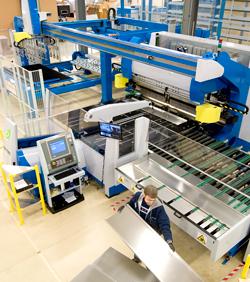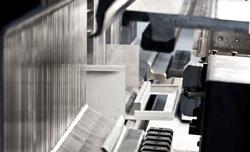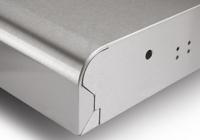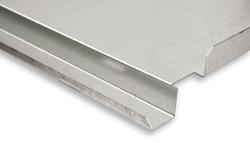Manager of Bending Products
- FMA
- The Fabricator
- FABTECH
- Canadian Metalworking
Categories
- Additive Manufacturing
- Aluminum Welding
- Arc Welding
- Assembly and Joining
- Automation and Robotics
- Bending and Forming
- Consumables
- Cutting and Weld Prep
- Electric Vehicles
- En Español
- Finishing
- Hydroforming
- Laser Cutting
- Laser Welding
- Machining
- Manufacturing Software
- Materials Handling
- Metals/Materials
- Oxyfuel Cutting
- Plasma Cutting
- Power Tools
- Punching and Other Holemaking
- Roll Forming
- Safety
- Sawing
- Shearing
- Shop Management
- Testing and Measuring
- Tube and Pipe Fabrication
- Tube and Pipe Production
- Waterjet Cutting
Industry Directory
Webcasts
Podcasts
FAB 40
Advertise
Subscribe
Account Login
Search
Discovering the best path to better bending
Analyze the options, from the stand-alone press brake to the fully automated panel bender
- By Michael Stock
- July 8, 2010
- Article
- Punching and Other Holemaking

: Figure 1: The level of bending automation you need depends on myriad factors, such as part size and expected volume. In this setup, an automated blanking and panel bending cell speeds the fabrication of large panels.
Think about the old days for a second. A single-station duplicator punch press was the epitome of blanking precision for many a contract fabricator. Then this new technology called a turret punch press came along. It could hold multiple tools, move the sheet to the right location, and cut interior holes and part profiles. Production went through the roof. Then the laser cutting machine emerged on the scene and removed tooling and the associated setup from the equation, increased part profiling and sheet nesting flexibility, and yielded higher machine efficiency and maximum throughput in high-mix, low-volume applications.
However, more important than that, for the first time the machine controlled part quality. As long as it had the right program and the correct punch tools or laser focusing head, a blanking machine could read and execute programmed instructions correctly from the first part onward. If another batch of those parts came in a week, a month, even a year hence, the machine could produce the exact same part.
To be sure, skilled personnel are still needed to program, set up, and maintain the machine, and periodic edge quality inspection is still as important as ever. But when it comes to process operation, a human no longer needs to monitor a machine continuously to ensure it makes good parts.
More recently bending technology has undergone a similar evolution, but admittedly, the challenges have been more complex. The modern press brake is now a CNC machine capable of high repeatability, but it still requires an operator to hold the part during the process and set up the tooling. A multiaxis robot can be integrated with the CNC brake to eliminate operator handling, but currently it does not efficiently address the tooling setup from one part to the next.
The panel bender changes this. The bending process can be fully automated—automatic tool setup, automatic part loading, complete part manipulation, and unloading (see Figure 1). It produces positive and negative bends quickly and accurately, no blank flipping required. The part stays flat on the machine table as only the flange is bent. Now, like the blanking machine, the bending machine controls part quality and, on some parts, forms in seconds what would take a press brake a few minutes.
Note the key phrase, though: some parts. Panel benders can’t handle everything a stand-alone or robotized press brake can, but then again it can do many profiles that are either very difficult or impossible to do in a press brake. In fact, bending automation has always been more complex. Aside from using punch form tools, blanking deals mainly with just two dimensions. In bending, you have all three to worry about.
Choosing which bending technology is best involves balancing maximum throughput with your expected return on investment. To uncover that, you need to have a good understanding of the bending requirements specific to your application and know exactly how your bending operators spend their day; that is, how much time they spend bending versus not bending. You need to know the setup times your parts require; downtime between jobs; the percentage of time operators are handling the part; your scrap rate, including scrap produced during setup (tryout parts) and rejected pieces produced during the run; and your average daily output of each machine. You need to know your expected part volume and optimal batch size that minimizes the cost of work-in-process (WIP). You also need to keep an open mind to all the bending options out there—and there are many.
Technology Basics
Press brakes are common for a reason: They’re inexpensive and versatile. If stage bending, you can carry a complex part through multiple bends on different tool sets within one brake bed, and finish a complex part after just one handling. If you’re using special tools, such as an offset punch and die set, and if the brake has sufficient tonnage, you can bottom-bend a complex geometry precisely, in one hit.
But the brake has drawbacks that have given head-aches to many a metal manufacturer. Often the press brake remains the operation’s principal bottleneck. Why? It’s because of setup and the high level of operator skill generally required. It takes time to switch out tools and create or retrieve an existing program, and it may take a few tryout pieces to make a good part. Recent press brake technology has helped reduce this time via quick-change tool clamps, multiaxis backgauges, and real-time control feedback that detects variances in material.
But the basic premise of brake bending has remained the same for decades. The brake applies pressure to the blank in three places: the two die shoulders on the bottom and the punch tip on the top. To air-bend, the punch descends a predetermined distance into the V die, below the die shoulders. Mathematically, you can determine how far the punch needs to go to bend a sheet of a certain thickness to the specified angle. This equation involves not only the final outside radius desired, but also the material thickness. So as thickness varies unexpectedly, the radius changes a little bit, which influences the actual bend angle—hence the need for those test parts.
A panel bender is different. The material isn’t bent with pressure applied on both sides of the metal. Instead, the sheet is positioned under a hold-down tool and a flange is bent in the positive or negative direction. A bottom blade moves up to bend positively; a top blade moves down to bend negatively (see Figure 2 and Figure 3).
The upper hold-down tool segments and stationary bottom hold-down tool clamp the blank in place, but they don’t directly form the metal. The only forming pressure applied comes from those upper or lower blades. The sheet metal is formed with just one pressure point from the blade on one side of the sheet—a lot less complicated than the press brake’s three points of pressure. The blades approach the flange in a curved movement (technically speaking, through interpolation of two axes), so they maintain a single point of contact throughout the bend. Without this, the blade would slide against the flange during bending. The curved movement also allows for complex bending operations, like radius bumping, without specialty tools (see Figure 4).
Panel Bending Advantages
Automated panel benders thrive on large workpieces with both positive and negative flanges that are difficult to handle in the press brake. Also, material variation and springback can be less significant on a panel bender because the bending method generally puts less stress on the workpiece.
Referencing differs in a panel bender. Before bending, the sheet is placed against locating pins. The hold-down tools clamp on, the locating pins move out of the way, and the upper and lower blades move in to commence bending, starting with the outermost bend and moving inward. Because the machine handles the part during bending, it can reference all bends from the center of the blank out. This means bends aren’t referenced off of previous bends, as they are with a conventional CNC press brake, with operators holding those prior bends against the backgauge. It doesn’t matter how sophisticated a press brake’s backgauge is; if a previous bend is off, those loose tolerances will accumulate over subsequent bends.
In a panel bender, the angle is determined not by the tooling, but by the motion of the top and bottom bending blades. It’s the hold-down tool segments that must be changed out for various part widths. Many panel bender models change out these upper tools automatically, often within a few seconds (see Figure 5).
An automated panel bender uses a manipulator to move the blank by sliding it into the hold-down tools to correctly position the bend line for the required bend sequence, then turning it to the next side. Some stand-alone panel benders remove the table and manipulator, leaving blank manipulation to a human operator or articulating-arm robot.
Panel Bending Limits
Knowing this, you might wonder why all the press brakes in the world aren’t replaced by panel benders. Sure, the panel bender is more expensive than the press brake, but a panel bender’s productivity is so much greater. So it’s not just about the price tag. It’s really because a panel bender can’t handle everything a press brake can.
Most benders can’t handle stock thicker than 11-gauge mild steel. Also, automated panel benders work with parts that are only so small, generally a little more than 6 in. wide, depending on the exact part dimensions and bend requirements. Anything smaller and the manipulator can’t handle the part (see Figure 6). Stand-alone panel benders don’t have a manipulator, but parts still must be large enough to be handled by at least one 4.5-in.-wide hold-down upper tool segment.
Panel benders can form flanges only so high or long. Typical applications involve flanges 8 in. and less. This is due to the panel bender’s design. Behind those upper and lower bending blades is a rigid C frame with (you guessed it) an 8-in. throat. Any flange greater than that would interfere with the machine.
Some panel benders also can have trouble with some interior flanges, no matter their height. Picture a 4-foot-square blank with a cutout window in the center having a flange on at least two sides, which need to be bent up. Remember the panel bender’s 8-in. throat? In most cases, the sheet can’t be positioned far enough in to make those bends. And even if it could, the manipulator common to most automated panel benders couldn’t hold the part, because the material is missing in the center.

: Figure 3: Behind the panel bender’s hold-down tool segments, shown at left, are two bending blades. One moves up for positive bending, the other moves down for negative bending (blades are shown in the center, at the bottom and top of the image).
Similarly, a panel bender has trouble with blanks with punched forms, such as louvers, specifically on the negative side of the sheet. The sheet can’t lie flat anymore, which means it won’t suit a panel bender.
Such benders also can’t bottom-bend an offset or some other special form profiles like a press brake can, and this makes certain precision bend geometries better-suited for the press brake, particularly those formed in one hit with special tools. For instance, some jobs require a one-metal-thickness offset on the edge of a panel so it can fit up with an adjacent panel when assembled. A panel bender can air-bend this to a lazy offset, which may be suitable, but it can’t do it with the precision, 90-90-degree accuracy obtained with the special single-hit offset tooling in a press brake, provided the brake has sufficient tonnage.
Avoid Tunnel Vision
Still, such an offset bend could be formed upstream in a turret punch press using a wheel tool, then make its way to the panel bender for the remaining bends. This fact proves an important point: Avoid tunnel vision when it comes to bending options. It isn’t just about what bends a machine can do; it’s about what combination of technology produces maximum throughput and quick ROI. A large percentage of parts usually can be redesigned to maximize the advantages of this technology.
For automated panel benders, an acceptable ROI usually requires higher part volume. Note that “volume"? in this sense doesn’t mean large batch sizes. On the contrary, one of the greatest advantages of a panel bender is that it can be programmed to bend short runs of complex parts with mere seconds of hold-down-tool changeover time between them. These machines are great at handling very small batch sizes. The more setup time an operation takes on a press brake, generally the more time a panel bender can save. So in this case, “large volume"? may mean a great number of short-run parts. Call it “high mix, high volume."?
Of all the bending options, the stand-alone press brake is the least expensive, followed by the robotized press brake. A stand-alone panel bender is generally more expensive than that (depending on product configurations), followed by the same panel bender with an integrated robot. Finally, there are the fully automated panel benders and integrated flexible manufacturing systems with material and part retrieval.
Some might raise their eyebrows at the stand-alone panel bender: Why is it more expensive than the robotized press brake? Here, you have to look at efficiency and productivity, particularly when it comes to complex parts. Robotized press brakes are great at handling large, heavy parts that would strain operators. But if a person spends a lot of time setting up a press brake for a certain group of short-run jobs, so will the robot. A robot may be able to move faster, and it doesn’t go out for a coffee break or call in sick, but it still must go through all the motions a human would.
Consider the conundrum many job shops find themselves in during this economic recovery. They survive on short-run jobs that keep money coming in the door, but those jobs can cause huge headaches on the floor.
Say you have 60 or so orders of 10-piece runs requiring complex bends and multiple tool changes on the press brake. With a stand-alone press brake, you spend most of your time setting up tools and moving material. And a robotized press brake doesn’t necessarily make things easier. Those 60 parts of different geometries may require about 30 grippers for the robot—and what robot cell has enough room for 30 grippers? If you want the robot to change out tools, you’ll need more grippers, or a person will need to intervene to perform setups manually. That makes for a cluttered robot cell and a lot of extra robot movement, complexity that may outweigh any increase in part consistency or reduction in bending cycle time the robot may achieve.
The stand-alone panel bender, though, is different. You call up the program (often by just scanning in a bar code on the job traveler), and robotic manipulators change out the hold-down tools. You place the part against the locating pins, and the machine takes it from there, completing the operation in a few seconds or minutes (see Figure 7). If you integrate an articulating-arm robot within the panel bending cell, you eliminate the need for human intervention entirely. A complex part might take 50 seconds on a stand-alone panel bender, with or without a robot, while that same part would take 3 or 4 minutes in a robotized press brake.
This isn’t to say a robotized press brake can’t be a smart investment. If your batch sizes generally are 25 or more pieces and parts are of average complexity, then one skilled brake technician can operate several automated brake cells and send productivity sky-high. But just be aware that a robotized press brake cell isn’t the only option to increase efficiency, improve part quality, or automate the bending operation.

: Figure 4: A panel bender’s bending blades move in a curved motion to perform complex bending operations, including radius bumping.
Equipment Choice: Where to Begin
A shop with three press brakes that bend 50,000 pieces a year isn’t going to be able to justify an automated panel bender. Such a machine would bend parts quickly and then sit idle most of the time. Yes, as any lean manufacturing guru will tell you, machine idle time isn’t a bad thing; overall manufacturing time is what really matters. All the same, 50,000 pieces can bring in only so much annual revenue. If such a shop isn’t expecting to increase sales significantly, it would take a long, long time to recoup the investment.
A good candidate for automated panel bending is a shop with four or more press brakes processing roughly 100,000 parts or more a year. This "minimum volume" number is for the ROI calculation. The more volume you have (again, this could be a great number of extremely short-run parts), the faster ROI you’ll get. An automated panel bender running over two shifts can produce roughly 350,000 pieces a year. Obviously, such machines give a shop tremendous capacity.
A shop with a dozen or so press brakes might run as many as a few thousand part geometries over one year. An automated panel bender may be able to handle only 30 to 40 percent of those parts. But if that percentage consists of large volumes, or if those parts require long setup times and are difficult to handle, a panel bender would produce a quick ROI. It would increase part consistency and, because setups happen in seconds, allow the shop to run even smaller batch sizes to reduce the cost of WIP.
But what if that 30 to 40 percent doesn’t entail a large enough volume of total parts? Here the automated panel bender might not be the best solution. In this case, a stand-alone panel bender that does not have a manipulator might suit, because it can handle a greater variety of blank sizes—perhaps enough to handle 60 to 70 percent of your part mix. Also, like with the automated panel bender, the stand-alone panel bender can send setup and cycle times plummeting. A shop with four press brakes needing to increase capacity may consider adding two more. But the stand-alone panel bender alone might be able to do the work of four press brakes. This means the shop could invest in the bender and actually sell two of its existing press brakes—and still increase capacity while reducing WIP.
But what if even the stand-alone panel bender can’t handle that many parts? What if a shop runs a variety of sheet thicknesses, with only 30 percent of the part mix being 11-ga. or thinner? Or perhaps it deals with a large portion of parts requiring flange lengths longer than 8 in., and they happen to be awkward for a person to handle, but still easily stackable or otherwise manipulated. In these cases, a robotized press brake might suit best.
In fact, an articulating-arm robot, in a press brake cell or tied to a stand-alone panel bender, has its own advantages. Once it’s finished bending, that same robot can send the bent part to downstream operations. Want to put the part on a conveyor to send it to a downstream cell for hardware insertion? An articulating-arm robot can do that. How about placing a bent piece in a welding fixture? A robot can do that too. In fact, the robot creates a palette of possibilities that other forms of automation don’t offer.
Growing With Automation
The level of automation you choose and how quickly you achieve an ROI depend on the number of parts that flow through the shop. As that volume grows, so generally does the level of automation.
For many, it happens incrementally. A shop first invests in a level of bending automation that gives a suitable ROI for their projected part volume. That piece of automation increases the shop capacity and shortens lead-times, making the whole operation more competitive.
Part volumes grow. The volume may come from a large number of short-run jobs, but again, panel benders can handle those small lots quickly and easily.
As volume grows further, the shop invests in more automation, perhaps a flexible manufacturing system (FMS) that can retrieve cut parts from the blanking machine, store them, and then send them on to the bending cell a few minutes or hours later. The FMS is carefully timed for optimal line balancing so that all components arrive at downstream processes at the right time (see Figure 8).
The right automation adds capacity without adding more people, increasing the value of each skilled employee. Skilled press brake technicians, those who really know the fundamentals of sheet metal bending, remain incredibly valuable assets, and they are difficult to find even during these challenging economic times. One technician, who perhaps once spent his or her day standing by one press brake bending parts, can become much more valuable operating two or three automated cells simultaneously.
About the Author
Michael Stock
555 W. Algonquin Road
Arlington Heights, IL 60005
847-952-6500
subscribe now

The Fabricator is North America's leading magazine for the metal forming and fabricating industry. The magazine delivers the news, technical articles, and case histories that enable fabricators to do their jobs more efficiently. The Fabricator has served the industry since 1970.
start your free subscription- Stay connected from anywhere

Easily access valuable industry resources now with full access to the digital edition of The Fabricator.

Easily access valuable industry resources now with full access to the digital edition of The Welder.

Easily access valuable industry resources now with full access to the digital edition of The Tube and Pipe Journal.
- Podcasting
- Podcast:
- The Fabricator Podcast
- Published:
- 04/16/2024
- Running Time:
- 63:29
In this episode of The Fabricator Podcast, Caleb Chamberlain, co-founder and CEO of OSH Cut, discusses his company’s...
- Trending Articles
Capturing, recording equipment inspection data for FMEA

Tips for creating sheet metal tubes with perforations

Are two heads better than one in fiber laser cutting?

Supporting the metal fabricating industry through FMA

Omco Solar opens second Alabama manufacturing facility

- Industry Events
16th Annual Safety Conference
- April 30 - May 1, 2024
- Elgin,
Pipe and Tube Conference
- May 21 - 22, 2024
- Omaha, NE
World-Class Roll Forming Workshop
- June 5 - 6, 2024
- Louisville, KY
Advanced Laser Application Workshop
- June 25 - 27, 2024
- Novi, MI



























